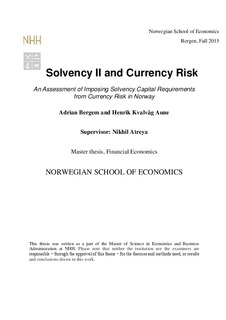Solvency II and currency risk : an assessment of imposing solvency capital requirements from currency risk in Norway
Master thesis
Permanent lenke
http://hdl.handle.net/11250/2383144Utgivelsesdato
2015Metadata
Vis full innførselSamlinger
- Master Thesis [4372]
Sammendrag
We assess the new EU directive for insurance companies, Solvency II, with regards to
solvency capital requirement (SCR) from currency risk and its implications on risk
management for Norwegian life insurers. The SCR is designed to offset losses during extreme
market conditions. We question whether the direct adoption of the standard formula stipulated
in the directive is reasonable for the Norwegian insurance market, as the Norwegian krone has
historically had different characteristics than the euro. The parameter of interest is the input
correlation factor between currencies and equities due to its impact on the SCR from currency
risk through diversification effects. In the standard formula, this parameter is currently set to
0.25.
We conduct this assessment by creating a back-testing model with a sample period from 2003
to 2015 for international equity portfolios with various hedge ratios and computing the
corresponding SCR. To ensure quality and relevance we have based our assumptions in the
model on information from interviews with five major life insurers in Norway.
We find that a hedged portfolio underperforms its unhedged counterpart with respect to rate
of return, volatility and, in particular, downside volatility. Downside volatility is what
Norwegian life insurers mainly focus on because of the asymmetric payoff profile of their
defined benefit pension products. By performing correlation and regression analyses, we find
that the superior performance of the unhedged portfolio is caused by a predominantly negative
correlation between the returns of the Norwegian krone (NOK) and international equity
markets. This is due to the NOK’s risk-on characteristics, meaning that the currency is
negatively correlated with the risk perception in financial markets. We thus argue that adopting
the input correlation parameter from the standard formula is questionable as it contradicts these
historical market dynamics. Furthermore, we find that the SCR from currency risk is
significantly dependent on the input correlation factor, meaning that Solvency II will
incentivize Norwegian life insurers not to lower their hedge ratios, and by doing so, might
work against its goal of increasing financial stability.
